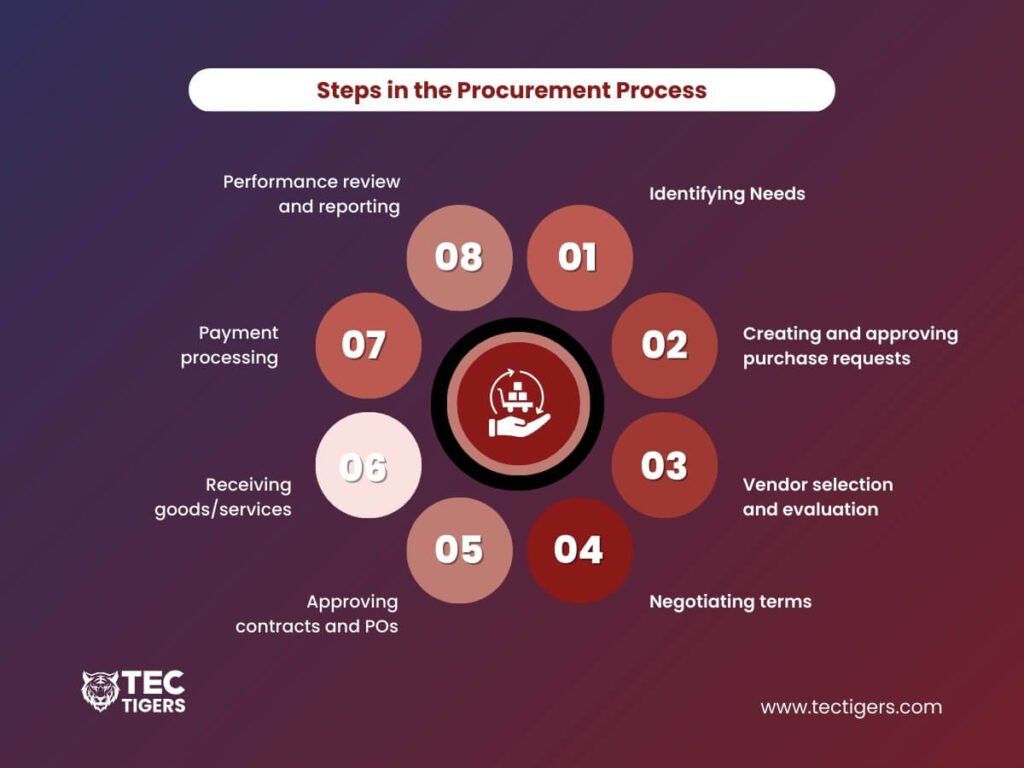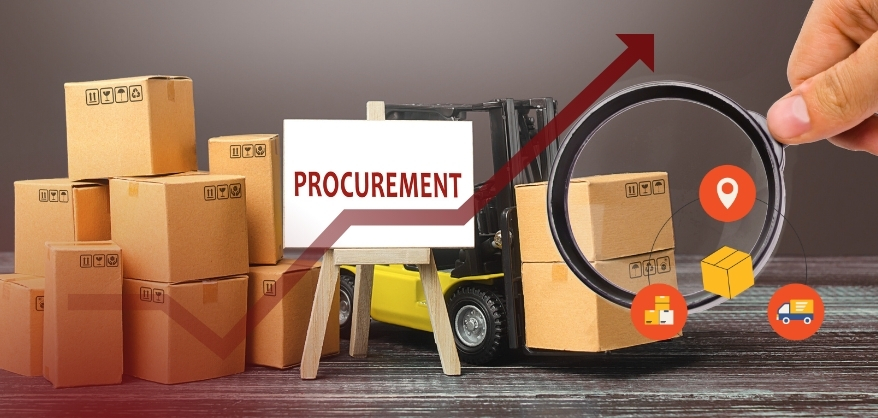Table of Contents
- What is a Procurement Process?
- Benefits of Using Procurement Tools
- Key Benefits of the Procurement Automation Process
- Procurement Automation Features Table
- Steps in the Procurement Process/Cycle
- 8 Tools That Can Accelerate Your Procurement Cycle
- How to Optimize Your Procurement Process with Tectigers?
- FAQs
Procurement cycle delays are like a slow leak in your business engine — they waste time, drain resources, and put you at risk of missing strategic opportunities.
With supply chains in the US and UK becoming increasingly complex and with rising compliance requirements, decision-makers can no longer rely on manual, time-consuming processes. By leveraging the right procurement tools, your business can accelerate procurement cycles, cut costs, and strengthen supplier relationships in both domestic and international markets.
If your company is also working on improving supplier negotiations, you may want to review our contract negotiation strategies to complement these tools.
What is a Procurement Process?
The procurement process, also called the procurement cycle, is the end-to-end set of steps your organization follows to source goods or services.
In the US and UK, procurement processes must also account for region-specific factors — from US federal procurement regulations to UK Public Contracts Regulations (PCR) compliance for public sector buyers.
Common steps in the procurement process include:
- Identifying needs
- Creating and approving purchase requests
- Vendor selection and evaluation
- Negotiating terms
- Approving contracts and POs
- Receiving goods/services
- Payment processing
- Performance review and reporting
A robust procurement process ensures that businesses in the US and UK achieve not just cost savings but also long-term supplier value.

Benefits of Using Procurement Tools
Without the right procurement management tools, teams spend excessive time on repetitive tasks and firefighting urgent issues.
Here’s how top procurement tools can help:
- Time savings: Automating routine steps like PO approvals and invoice matching.
- Cost reduction: Data-driven vendor selection to avoid overspending.
- Compliance: Standardized workflows that follow company and legal requirements.
- Transparency: Real-time visibility into the procurement process flow.
- Better decisions: Analytics and reporting to guide purchasing strategies.
“Organizations that invest in procurement automation reduce their cycle times by up to 64%.” – CIPS Global Procurement Report 2025
Key Benefits of the Procurement Automation Process
Procurement automation isn’t just about speed — it’s about making smart, consistent, and scalable decisions.
Top benefits include:
- Reduced manual errors – Automated PO generation eliminates typos and duplicates.
- Streamlined vendor management process – Single platform to manage all suppliers.
- Improved cash flow control – Integration with supply chain finance and payment systems.
- Better spend analysis – Identify savings opportunities faster.
- Enhanced collaboration – Teams and suppliers work in a unified digital environment.
Procurement Automation Features Table
| Feature | Description | Business Impact |
| E-Procurement | Online system for request-to-pay workflows | Cuts paperwork, accelerates approvals |
| Supplier Relationship Management (SRM) | Tools to track, evaluate, and engage suppliers | Improves long-term supplier performance |
| Purchase Order Management | Automated PO creation and tracking | Reduces bottlenecks and delays |
| Contract Management | Digital storage, reminders, and compliance checks | Prevents contract breaches and missed renewals |
| Spend Analytics | Real-time data visualization of spending | Enables strategic cost-saving decisions |
| Strategic Sourcing | Data-driven supplier selection process | Increases procurement efficiency |
Steps in the Procurement Process/Cycle
To accelerate your procurement cycle, you first need to understand the procurement life cycle itself.
Typical procurement cycle steps:
- Needs Identification – Departments submit purchase needs.
- Purchase Requisition – Formal request for approval.
- Vendor Selection – Using strategic procurement process methods.
- Contract Negotiation – Review the contract negotiation checklist to ensure compliance.
- Purchase Order Creation – Digital or automated issuance.
- Order Fulfilment – Vendor delivers goods/services.
- Invoice & Payment Processing – Linked with finance.
- Performance Review – Continuous supplier evaluation.
8 Tools That Can Accelerate Your Procurement Cycle
Choosing the right set of procurement tools is like upgrading from a bicycle to a high-speed train; it’s not just faster, it’s smarter, more reliable, and built to handle future growth.

E-Procurement Platforms
E-procurement platforms digitize the entire procurement process flow — from requisition to payment — eliminating the bottlenecks caused by paper-based or email-driven processes. These platforms integrate seamlessly with ERP systems, ensuring data consistency across departments.
Business Benefits:
- Faster requisition approvals with automated workflows.
- Real-time visibility into budget and supplier performance.
- Standardized templates for POs and RFQs.
E-Procurement Platforms Tools: SAP Ariba, Coupa, Jaggaer
Imagine a manufacturing company that processes hundreds of purchase requests per month. With e-procurement, approvals that once took 5 days now happen in under 24 hours.
Contract Lifecycle Management (CLM) Software
Contracts are at the heart of procurement, and poor contract management leads to compliance risks and missed opportunities. CLM software stores, organizes, and tracks all contracts in a centralized repository while automating alerts for renewals and obligations.
Business Benefits:
- Avoids costly auto-renewals of underperforming vendor contracts.
- Improves compliance with audit trails.
- Integrates with the contract negotiation checklist to ensure clauses align with company goals.
Contract Lifecycle Management Tools: Icertis, DocuSign CLM, Concord
Example:
A retail chain utilizes CLM to manage over 1,000 supplier agreements. The system flags contracts that are due for renegotiation, prompting strategic speed-up of complex contract negotiations that save millions of dollars annually.
Supplier Relationship Management (SRM) Tools
SRM tools are like CRM systems for your suppliers — they track supplier performance, risk profiles, and collaboration history. Strong supplier relationships lead to better pricing, priority service, and innovation partnerships.
Business Benefits:
- Centralized supplier data.
- Better supplier onboarding and compliance checks.
- Enhanced vendor communication through shared dashboards.
Supplier Relationship Management Tools: Oracle Procurement Cloud, GEP SMART, Jaggaer SRM
A global food distributor uses SRM to identify which suppliers consistently deliver ahead of schedule, securing them as preferred partners during high-demand seasons.
Spend Analytics Tools
Spend analytics tools turn raw purchasing data into actionable insights. They identify spending trends, uncover maverick spending, and suggest cost optimization opportunities.
Business Benefits:
- Clear visibility into category-wise spending.
- Early detection of budget overruns.
- Supports better strategic procurement process decisions.
Spend Analytics Tools: Zycus Spend Analysis, Coupa Analytics, Sievo
An IT services company discovers through spend analytics that 15% of its hardware purchases come from non-approved vendors, enabling swift corrective action.
Strategic Sourcing Platforms
Tools: Scout RFP, Keelvar, MarketDojo
Strategic sourcing platforms use market data, AI, and supplier scorecards to help organizations choose vendors that deliver the best combination of cost, quality, and reliability.
Business Benefits:
- Faster RFP creation and distribution.
- Data-backed supplier comparisons.
- Optimized long-term sourcing strategies.
A healthcare provider leverages strategic sourcing to identify a new medical equipment supplier that offers 12% lower prices with a faster delivery lead time.
Purchase Order Management Systems
Purchase Order Management Tools: Procurify, Kissflow Procurement, Fraxion
Automating the purchase order process ensures that POs are created, approved, and tracked efficiently. These systems reduce manual entry errors and prevent duplication.
Business Benefits:
- Reduced PO cycle time from days to hours.
- Real-time PO status tracking.
- Integration with inventory management for stock accuracy.
Procurement Automation Suites
Procurement Automation Tools: Basware, Kissflow Procurement Cloud, Coupa Procure-to-Pay
Full-suite procurement automation combines multiple functions — e-procurement, invoicing, supplier management, and spend analysis — in a single platform.
Business Benefits:
- Fewer software integrations to manage.
- End-to-end visibility over the procurement cycle steps.
- Reduced operational costs through automation.
Supplier Risk Management Tools
Supplier Risk Management Tools: Riskmethods, Achilles, Resilinc
Global supply chains face risks from political instability, natural disasters, cybersecurity threats, and more. Risk management tools track these factors and alert procurement teams proactively.
Business Benefits:
- Minimized disruption to the supply chain process.
- Early warning systems for high-risk suppliers.
- Compliance with regulatory requirements.
An electronics company uses a supplier risk tool to identify that one of its component vendors is located in a region with an upcoming trade embargo, allowing it to secure alternative suppliers in advance.

How to Optimize Your Procurement Process with Tectigers?
At Tectigers, we help businesses transform their procurement strategy through:
- Digital procurement transformation consulting
- Custom procurement automation system integration
- Data-driven vendor evaluation
- Purchase order process optimization
- Supply chain process mapping
Whether you’re looking to improve procurement cycle steps, integrate AI into your strategic sourcing, or implement supplier relationship management, our team ensures you achieve faster cycle times without compromising compliance.
FAQs
What is an RFQ in procurement?
RFQ stands for Request for Quotation. It’s a formal document that a buyer sends to potential suppliers, requesting detailed pricing, terms, and delivery information for specific products or services. In the procurement process flow, RFQs are typically used when requirements are clear, allowing suppliers to compete primarily on price and delivery terms.
What procurement process is used in your business?
The process varies by company. Some use a fully automated e-procurement and procurement automation system, while others rely on manual processes. The choice depends on procurement maturity, budget, and business size.
What is the procurement life cycle?
It’s the complete journey from identifying a need to contract closure and supplier evaluation. A well-managed procurement life cycle ensures cost control, compliance, and consistent supply..
What is PO in procurement?
A Purchase Order (PO) is a formal, legally binding document issued to a supplier specifying the product/service, quantity, price, and terms.
What are the 7 principles of procurement in order?
The principles are value for money, Ethics and fairness, Transparency, Accountability, Competition, Sustainability, and Innovation.
Global Procurement Lead
Skilled in strategic sourcing, vendor management, and cost optimization, 7+ hands-on experience in streamlining procurement operations. Offers valuable insights into modern supply chain practices and is dedicated to helping businesses achieve efficiency and value through data-driven procurement.




